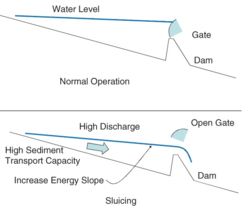Sediment sluicing
Contents
Introduction
Reservoir sluicing aims at passing sediment through the dam without allowing deposition. In contrast to flushing which aim to remove deposited sediments, reservoir sluicing focuses on in-coming sediments that are not deposited in the reservoir. Sluicing is performed at periods of high flows, when there is high concentration of sediments in the water, while flushing is executed outside flood and high-flow periods. Reservoir sluicing is not a measure designed for ecosystems living in regulated rivers. However, the supply of sediments induced by sluicing can help to re-balance the deficit in the downstream river if the timing of the operation and the amount of sediments flushed match the transport capacity of the river (Morris et al. 1998, Tigrek et al. 2011, Kondolf et al. 2014). The advantage of this measure is that large amount of sediments is transported during high flows, matching with the transport capacity of the river at this period.
The objective of sediment sluicing is to maintain the sediments in suspension when they enter the reservoir and convey them out via sluicing gates. Reservoir sluicing necessities a partial emptying of the reservoir prior to flood periods and the incoming of sediment-laden flows. Outlets (sluicing gates) located at low level of the dam are opened allowing passing sediments. Outlets need to have a large flow capacity in order to ensure that high-flows and flood water passing.
Methods, tools, and devices
During planning
Future needs for sluicing operations should be anticipated already in the planning phase of dam and reservoir construction. Appropriate location and level of gate will depend on the characteristics of the dam and should be incorporated in the design of the dam. In best cases, low-level gates can still be implemented after the construction of the dam, but the cost of implementation will be higher.
Time-series of hydrologic and sediment data are necessary to design the dam and anticipate sluicing operations (see Chapter 5.1.1).
Hydraulic and sediment transport models can be used to estimate yield of sediments to the reservoir, projections of future sedimentation load, sediment trapping rate in the reservoir and sediment transport capacity of the river. Sluicing operations can be simulated with numerical models such as FLUVIAL-12 (see Chapter 9.1 for reference).
Sluicing can be implemented in all reservoirs, but the duration of the operation varies from some hours to several months according to hydrological catchment size, reservoir storage capacity and characteristics of the flood period.
Sluicing operations can be simulated using numerical models to estimate the timing and the duration of the drawdown period, as well as the drawdown level and the velocity required to transport all sediments downstream the dam.
During implementation
During sluicing, the reservoir is drawn down at low level. Gates are opened to let high sediment-laden water flow through the reservoir. The success criteria for flushing are:
- low reservoir water level conjointly with high discharge
- low-level gates located close to the bottom of the dam
- steep river bed and straight reservoir bottom slope
- sediments consist of fine material recently deposited.
Concentration of suspended sediments and turbidity levels in the river must be monitored during sluicing operations to ensure that their value remain under ecosystems thresholds and that the operation does not have significant impacts on the physical and chemical environment.
During operation
There is basically no maintenance needed for this measure, except that the process of adding dead trees might be needed to be repeated if the wood is gradually degraded or drifts away in larger parts. Monitoring of the effect of the measure can be done by for instance electro-fishing in order to assess the density of juvenile fish and compare this to densities in sections where shelter is limited.
